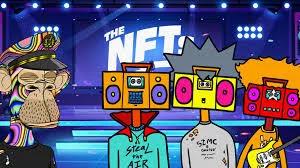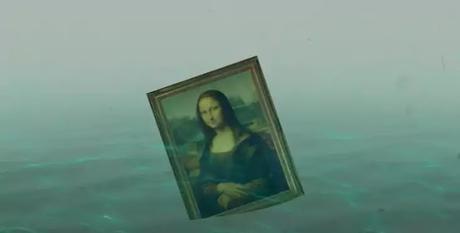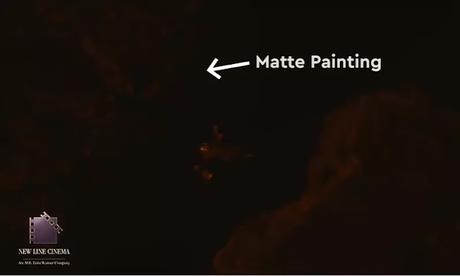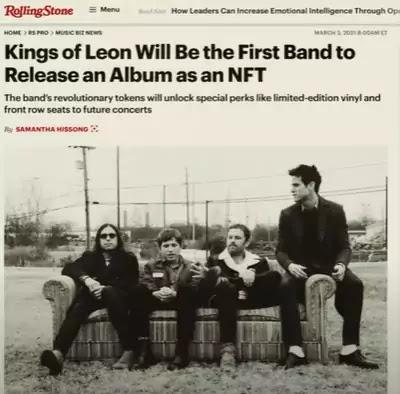
pic credit: creative bloq
There are two things you should be aware of when it comes to NFTs:
1- Millions of individuals trade with them, but the majority are just looking for fast cash.
2- The potential impact of NFTs on society and the web is enormous. They may be able to help us move forward by reducing our dependency on tech behemoths. It's for the best. That is something I am certain of.
I've been delving deeper and deeper down this rabbit hole for the past two weeks, and I've been consistently amazed. Because the current price manipulation and speculation around NFTs may end up jeopardizing this amazing piece of technology for everyone.
Many individuals that trade NFTs don't comprehend them, aren't innovating with them, and aren't thinking of new methods to use the blockchain. So many of them are rushing in to attempt to identify the next viral collection, inflate the price, and then sell it.
I'm getting ahead of myself, though. Before I go down that rabbit hole, I want to make sure you understand NFTs and, more importantly, what they mean for the internet's future.
What are NFTs
Art, I believe, is a better way to explain this. In 1503 or 1506, a man named Francesco del Giocondo commissioned a portrait of his wife. As a result, he contacted this up-and-coming artist, who agreed to paint it for him. However, he was never given the artwork. It was passed on to his student.
Then it was acquired by a king, and since then, all of this artist's work has become valuable. And while everyone thought the artwork belonged to him, no one knew for sure until 500 years later! They discovered this notation in Da Vinci's notebook in 2005, stating that he was working on this picture.
We've all decided that this picture is extremely valuable as a society. As a society, we’ve all agreed that this painting is worth a lot. It’s the best known, the most visited, the most written about, the most sung about, the most parodied work of art in the world.

pic credit: google images
In the 60s, the French agreed to lend it to the Americans for an exhibition, so it had to cross the Atlantic. And in case something went wrong, they had to put a price on it for insurance. The insurance people got together and agreed that it was worth $100M- or $680M in today’s money. World record.
This estimation, however, is just a number someone came up with. It's fugazi. But why do we think it’s worth that? Because as a society, we agree to attribute value to unique things. You can very well argue that it is just a canvas with some paint on it. But this is a DaVinci original. When a group of people feels passionate about something, they collectively assign value to it.
That may very well be art, first edition books or vinyl, movie memorabilia, or Pokemon and Baseball cards. Whatever it is we are passionate about, if it’s special, we want to own it.
But even today, in 2022 with all our technology- we have art forgery, and copycats- you need to pay people to assess originals, and even they get it wrong sometimes. More importantly, art is no longer just a physical thing. Let me give you a more current example.
So many movies these days are shot on green screens- but many times those backgrounds are not 3D renders. So instead, an artist is commissioned to paint it. They bring photo references from a library, stick them together, blend them, paint a few bits, and create a Matte Painting.

So this scene in Lord of the Rings has a matte painting (the rocks in the background). A work of art, no doubt. A piece of digital art. Deeply embedded in pop culture, no less. So where is the original? It’s bits. It’s 1s and 0s. It’s a Photoshop file by Paul Campion.
And to a fan like me, or to other Lord of the Rings fans, the 'original' is special. You can screenshot it, but it's still not Paul’s file.
You can take Paul's Photoshop file and copy it, reproduce it, and it won't lose a single pixel of quality, but there is only one original file- the one Paul Campion worked on when producing Lord of the Rings, all of those years ago. THAT is special. THAT is unique. That is non-fungible.
And say you stalk Paul, create a whole plot to randomly meet him at a bar, to befriend him, become buddies so that 3 years down the road he gives you a copy file. Before NFTs existed, there was no possible, human way to prove that that file was THE original Paul worked on.
It'd be just as worthless as any other copy of the file. Just like the Mona Lisa is cotton and paint, or like that baseball card is paper and ink, the value is not in the materials, but in the uniqueness, the scarcity, and the value others assign to it. Could we do the same for bits?
It’s easier to tie value to a physical thing, but as the world becomes more digital, that perception of value is changing. So that NFT ownership, this certificate- is stored in a blockchain. The point is your ownership of this NFT is stored in this database, which is not owned by a single company but stored and maintained by a community of users.
And it’s, for all sorts and purposes, truly permanent, unchangeable Nobody can change it, or hack it- it’s permanent digital ink- forever. This is where it gets even more interesting. Checking that you own this unique NFT is super easy, can’t be faked, and that means they can be used for a lot of things.

pic credit: google images
For example, the guys from Kings of Leon took a bet- they auctioned 6 limited-edition NFTs of their latest album, which not only included a copy of the music- but front row seats to one King of Leon concert, one concert in each tour by Kings of Leon, for life.
So the NFT sort of becomes a key, a key like a golden ticket, unforgeable to unlock a real-life thing. But because it’s in the blockchain, the owner can sell it, trade it- and its value is determined by what other people are willing to pay for it. You can even code, say a 10% royalty into an NFT.
So for example, if the NFT is resold for $100,000- the creator of the NFT, the artist can collect the commission on the gains that his piece of art had. But let’s STOP for a moment. Because it’s not as simple to have nice things.
NFTs and Their Risks
Remember everything I said about the Mona Lisa is a unique piece of art? Just as NFTs became popular in late 2020, as the prices of crypto skyrocketed through the pandemic, people started minting NFTs like CRAZY.
These artists are creating collections of 5,000 or 10,000 small variations, usually small variations of an illustration, and they are promoting and hyping their collections with the sole purpose of flipping them for profit. And hundreds of collections, with thousands of illustrations each day, are created every day.
And these NFTs aren’t connected to anything. They don't have front road tickets to a concert. They are quite literally, just a JPG file. But people keep buying them and some of these collections, a fraction of a percent of them- have gotten popular between spheres of people with money and with influence…
Investors, and celebrities, and just people with a lot of Twitter followers have agreed that this pixel art, or that this ape has value. And it’s created a snowball effect- and if we’ve learned something with this series, is that people can fall for these schemes.
While most of the thousands of collections created every day never really take off- There are for example 6,000 Apes in circulations, the minimum price you can get for one is about $100,000 these days. That's even considering that if the price dropped significantly last week.
The value of the whole collection used to be $2.4 Billion for a collection of apes illustrations And honestly, this can be hard to resist. And this stuff triggers every single FOMO feeling for everyone.
I could make a $2.4B selling illustrations? Or buy it for $1,000 and sell it for $200,000. I mean it's easy money, I want in! I can't miss out And it’s of course found footing in some more mainstream uses. Adidas, the Weeknd, NBA! Most people are buying into these collections to make money- clearly not out of appreciation for the asset or the technology.
They buy them and help build hype around them with the hope of selling them to a higher bidder. Maybe, maybe there is room for a few collections of NFTs by a renowned artist, with a cult following, and digital bragging rights- But even in those cases, how much of the cult following is just driven by how expensive they are, and their tradable/resellable nature.
We can agree- please let’s agree that there isn't room for thousands of collections being worth Billions of dollars? Just like in that pyramid scheme, after a certain point, there aren't enough people in the world to turn a profit. This problem is gravely made worse by the fact that too many people have made too much money on crypto.
Crypto-millionaires are real, and people follow them and believe them because people are inescapably drawn to money, and to aspirational things. And we could just say screw them, let them speculate, let them lose their money; but what worries me is that this scammy behavior these crypto queens are achieving is panting a shade of distrust, of taboo into NFTs, cryptocurrencies, and anything blockchain-based.
Do I trust your advice? Do you really want to help me? Or are you just feeding the fire for your own benefit? to drive the price up of that token that you're super bullish on In this internet day and age, it’s not easy to say.
And so this gives us this fight, between the idealists that envision these technologies and their potential; and the people or the corporations with money, who are betting for, or against these crypto-technologies, and have their own interests fueling their opinions.
And it’s a shame. Because there are a lot of exciting uses for NFTs- people have come up with some amazing concepts for NFTs, but this speculation- people just mindlessly jumping on new NFTs to jack up the price- that is what endangers this whole ecosystem.
NFTs' Long-Term Potential
You’ve probably heard the term Web3, it’s usually tied into NFT conversations- because NFTs are an inherent part of how Web3 works. So let's do a quick recap here. When the internet first became mainstream, in the 90s, we had what we call now Web1.
Simple, static pages where content flows in one direction: from the site owner (and their team) to the public. And some people thought this was a fad, some people thought it was the future- and that all led to the infamous dot-com bubble, in the early 2000s.
After the bubble, the internet survived, of course. And a new kind of internet came to be. This Internet was alive, and it was powered by user content. Blogs, videos, pins, comments and discussions, and upvotes. These pages are empty shells, empty platforms owned by a company but powered by people. This is web2.
But web1 and web2 are both centralized. Everything is provided and stored by a centralized entity, and they get to collect all the data, they own all the information- for good or worse. Thanks to blockchain technology, databases no longer need to be owned by anyone. They could be owned by the community.
I’m oversimplifying here, but essentially if you believe in this project, you can buy a stake in it, share computing power to power it, and be paid in exchange for it. Web3, it’s all rather utopic, and again, all you can find now is polarizing opinions about whether or not it’s feasible. But some examples exist.
Decentraland is one of them. It’s this decentralized metaverse, where you can hang out, discuss. And digital elements in this metaverse are NFTs. Plots of land are limited, you can buy one and build a store, or a museum in it. This is maybe too abstract, too digital- but let’s go back to concert tickets.
Concert tickets suck. You often have to buy them resale tickets for high-demand events, and that adds the risk of forgery. If concert tickets were NFTs, the creator could bake in a rule so that the ticket can only be transferred/resold once, maybe twice.
They could also add a small royalty payment so the artist can make money if the resale price is higher than the original. As much as I don't like the guy, Gary Vee's NFTs are tied to tickets to his annual conference; which is, by all means, a pretty smart move.
There’s the silly character (because that’s what NFT traders understand that there's a character associated with these things, but the value is not so much on the character but much more on the real-world benefit).
Now, this is all very exciting, but there are two major hurdles we will need to overcome. First, the NFT art boom will end. I know it will. And when it does, a lot of people are going to lose a lot of money, and that might as well damage the web3 reputation forever.
But just like in the dot-com bubble, if the technology is exciting enough, if it has real-world use, if it improves the way we do some things, it could bounce back.
The next nurdle then is usability, and I feel this is one nobody talks about. Dealing with crypto and NFTs is REALLY, REALLY hard. It’s nowhere near mainstream adoption. My mother is nowhere near understanding, even less adopting it- and the speculation, the risk of scams makes it works.
No matter what a crypto bro tells you. It’s hard and confusing, and you could still lose everything if you lose a password- or if the price crashes. But that’s innovation. It’s trial and error. It’s ups and downs. You win and you lose just like with a startup.
The difference here is we have thousands of minds, communities getting together to create something new, something useful. Some people say NFTs and crypto are solutions waiting to find a problem. Even though they have existed for a decade, it’s still not clear cryptocurrencies are meant to be used for payments, or to store value- but they are still here.
Maybe it’s not the currencies, but the blockchain technology, the decentralized nature of crypto that finally finds a problem to solve. The power that tech giants have amassed is a problem, and what we are seeing is a potential very early solution.
Your parents aren’t adopting crypto this year, or the year after. As a matter of fact, we might need to wait for a day when NFTs are so seamless, you don’t even know you are using them, but we may just get there.

